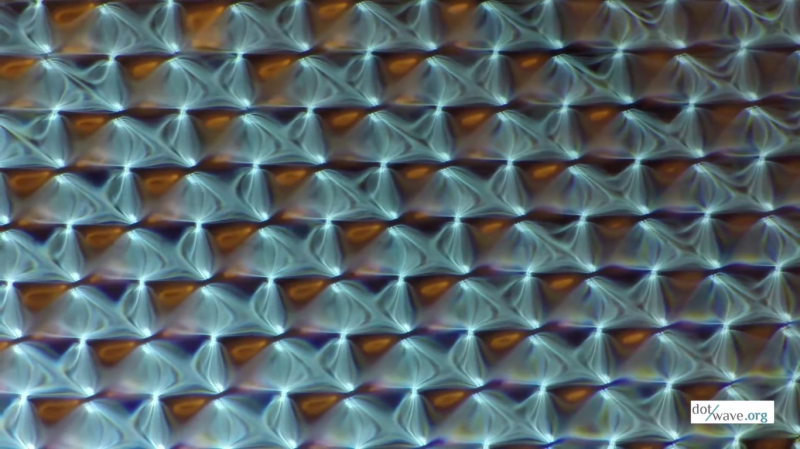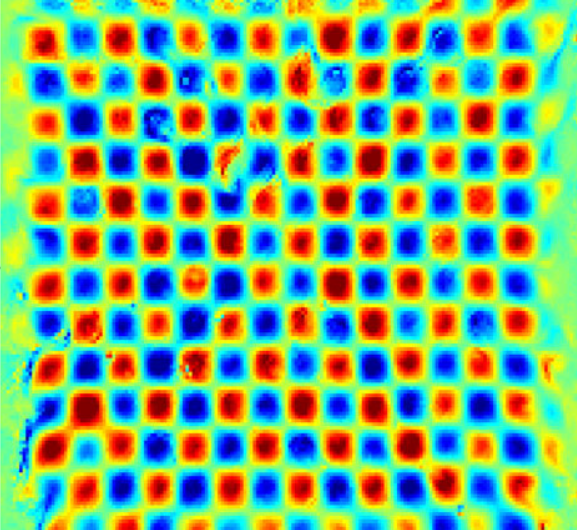Faraday waves, also known as Faraday ripples, are standing waves that appear on liquid surfaces in a vessel vibrating at a resonant frequency. The waves can form various linear, square and even hexagonal patterns. Credit: heligone / Samuel BERNARDET / Dotwave.org
Scientists from a number of Russian universities, including MIPT, have studied previously neglected phenomena and determined the cause of liquid vortex flow formed by surface waves. The results of the theoretical calculations were confirmed experimentally and published in Physical Review Letters.
The authors of the article—researchers from the Institute of Solid State Physics, Landau Institute for Theoretical Physics RAS and MIPT—developed and tested a capillary (micro) action theory, which can be used in the study of ocean vortices.
How vortices form
Vortices in liquids or near-liquid surfaces play a significant role in behavior patterns in objects of various sizes—from small receptacles to oceans. However, hydrodynamics research has not yet produced comprehensive knowledge of how to simulate them, as the physical processes are complex, even in a glass of water.
As previous research shows, horizontal vortices can be formed by surface waves during the friction between regions of liquid, where viscosity plays a pivotal role. However, the new study examined a different vertical vortex phenomenon caused by two surface waves moving in the opposite direction. The scientists discovered that vortices can be formed even in low-viscosity liquids.
The research team was the first to generate the process of vertical vortex flow in a liquid by manipulating surface waves. The crucial factor was tilting the surface, which was achieved by superposing two waves moving in the opposite direction. This effect was observed after creating Faraday waves during the experiment.
The red areas indicate counterclockwise rotation, the blue areas – clockwise rotation. Image courtesy authors of the study. Credit: Moscow Institute of Physics and Technology
The experiment
To test their theory, the research team used an almost square receptacle, since in a strictly square vessel waves in both directions are almost identical and the effect in question is too weak due to synchronic vibration. The 4x5 cm, 1 cm-deep vessel was filled with water and placed on a platform oscillating at a resonant frequency. Resonant frequencies create the maximum amplitude in a system, whether it's a pendulum, the water surface in a vessel, an oscillator, or even an electromagnetic field in a coil-capacitor circuit.
One to two seconds after the waves formed, the research team observed standing ripples along with a vortex lattice. This pattern corresponded with the equation calculated at the theoretical stage. Altering entry parameters changed the results of the experiment by a small margin; however, they all correlated with theoretical predictions.
What next?
As shown in a recent study by a group of Australian and Russian researchers, an oscillation frequency higher than a certain rate gives surface waves enough energy so that vortex interactions become sufficient to give a correct description of the system. The data analysis presented in the article will allow a thorough study of the effects in question, resulting in a relevant calculation model.
"Vortex interactions generate bigger vortices, which ultimately leads to vortices of significant size and high amplitude. These vortices can potentially have a considerable impact on ocean plankton movement. Further studies will provide more clarity on this subject," says the lead researcher Vladimir Lebedev, Director of the Landau Institute for Theoretical Physics RAS, Head of Chair at MIPT's Department of Physics and Nanostructure Technology, Corresponding Member of RAS.
More information: S. V. Filatov et al. Nonlinear Generation of Vorticity by Surface Waves, Physical Review Letters (2016). DOI: 10.1103/PhysRevLett.116.054501
Journal information: Physical Review Letters
Provided by Moscow Institute of Physics and Technology






















